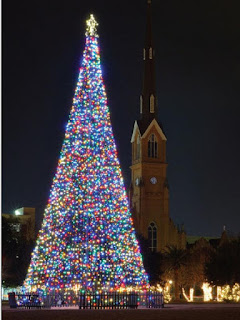On my Charleston Walking Tours I have been emphasizing Sherman's March this month. After leaving Savannah Georgia in mid January, he systematically burnt his way through South Carolina, leaving a swath of destruction and misery 40 miles wide. He was virtually unopposed until he attempted to cross the swampy Salkehatchie River. After a few days of stalling, the Confederates were overwhelmed and the enemy crossed the River. This is known as the Battle of Rivers Bridge.

After bivouacking and regrouping on the north side of the river, they exacted a heinous vengeance on the countryside. Sherman's orders to his men as they entered South Carolina was to burn everything except the houses of the plain folk (log cabins), but he made exception for the communities at the site that dared resist his advance. A terrorized civilian population witnessed the pillage and burning of their homes and outbuildings. Even slave quarters were torched, lest the whites seek shelter in them. Sherman's men ruthlessly and systematically burnt everything to the ground except the Mizpah Church. The farming community of Buford's Bridge, the site of my Ray Family Home Place, disappeared and never recovered. My brother formerly owned a charred plantation desk supposedly removed from the farm office before it was torched. Sitting on the ground as the office burnt, the building collapsed on the desk and it had to be rescued from the embers, or so the story goes. Sherman's men took great satisfaction in their pillage and destruction. Although some speak of rape, no stories of that survive in my family history or others I have read. But then again, recollections of such wouldn't be repeated , would they? All food stores and livestock--everything--was stolen. The livestock they couldn't carry was killed, crocks containing preserved food were shattered so that nothing remained to sustain the civilians.That pillage took place 150 years ago this week. For that reason, today I am reposting my blog entry on Southern Memory, for my friends from the North who don't get why we remember.
So Here It Is
I was looking for some information in the Charleston Mercury newspaper ( the old one, not the current newspaper) for an 1864 article. As often happens when I peruse, I found myself on other topics. I happened across a poem that somehow touched an ancient retained memory, one barely discernible in an age so far removed from the time of the War Between the States.You see, my family was burned out by Sherman's March. So many people move here from other places, with no understanding of Southern Memory. Perhaps this poignant poem will lend perspective.
Published in the Charleston Mercury
May 1864
At Fort Pillow.
By James R. Randall
You shudder as you think upon
The carnage of the grim report--
The desolation when we won
The inner trenches of the fort.
But there are deeds you may not know
That scourge the pulses into strife;
Dark memories of deathless woe
Pointing the bayonet and knife.
The house is ashes, where I dwelt
Beyond the mighty inland sea;
The tombstones shattered where I knelt
By that old Church in Pointe Coupee.
The Yankee fiend! that came with fire,
Camped on the consecrated sod,
And trampled in the dust and mire
The Holy Eucharist of God!
The spot where darling mother sleeps,
Beneath the glimpse of yon sad moon,
Is crushed with splintered marble heaps
To stall the horse of some dragoon!
God! when I ponder that black day,
It makes my frantic spirit wince--
I marched--with Longstreet--far away,
But have beheld the ravage since.
The tears are hot upon my face
When thinking what bleak fate befell
The only sister of our race--
A thing too horrible to tell.
They say that, ere her senses fled,
The rescue of her brothers cried;
Then feebly bowed her stricken head,
Too pure to live thus--so she died.
Two of those brothers heard no plea,
With their proud hearts forever still--
John shrouded by the Tennessee,
And Arthur there at Malvern Hill.
But I have heard it everywhere
Vibrating like a passing knell;
'Tis as perpetual as the air
And solemn as a funeral bell.
By scorched lagoon and murky swamp
My wrath was never in the lurch;
I've killed the picket in his camp
And many a pilot on his perch.
With deadly rifle, sharpened brand,
A week ago, upon my steed,
With Forrest and his warrior band
I made the hell hounds writhe and bleed.
You should have seen our leader go
Upon the battle's burning marge,
Swooping like falcon on the foe,
Heading the grey line's iron charge!
All outcasts from our ruined marts,
We heard th' undying serpent hiss,
And in the desert of our hearts
The fatal spell of Nemesis.
The Southern yell rang loud and high
The moment that we thundered in,
Smiting the demons hip and thigh,
Cleaving them to the very chin.
My right arm bared for fiercer play,
The left one held the rein in slack;
In all the fury of the fray
I sought the white man, not the black.
The dabbled clots of brain and gore
Across the swirling sabres ran;
To me each brutal visage bore
The front of one accursed man.
Throbbing along the frenzied vein,
My blood seemed kindled into song--
The death-dirge of the sacred slain,
The slogan of immortal wrong.
It glared athwart the dripping glaives,
It blazed in each avenging eye--
The thought of desecrated graves
And some lone sister's desperate cry.
Wilmington, April 25.


.JPG)
+-+Copy.JPG)
